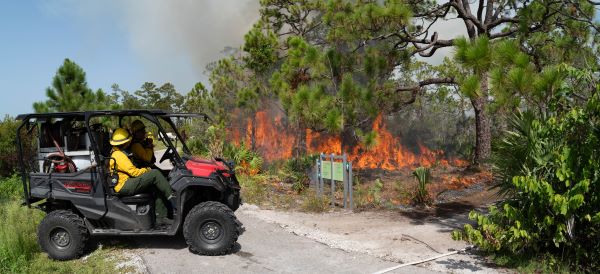
Being Naples Botanical Garden’s staff photographer and videographer is a dream job. I get to do a lot of different stuff, including chronicling Garden staff’s wide-ranging projects, taking portraits of visiting artists and dignitaries, and photographing the incredible plant collection. One of the most exciting things I’ve worked on is prescribed burns. Our Natural Resources team conducts these in collaboration with several organizations from the Central & South Florida Prescribed Fire Working Group, a coalition that includes, among others, the Florida Forest Service, the Florida Department of Environmental Protection, Florida Fish and Wildlife Conservation Commission, Conservation Collier and, of course, the Garden.
Many of Southwest Florida’s native habitats are adapted to fire — they need flames as much as water to stay healthy. We lacked the resources to conduct prescribed fires in the Garden’s earlier days. Recent burn efforts are the result of years of behind-the-scenes infrastructure setup and training. Now armed with alliances, safety protocols, and staff expertise, we started a prescribed fire regimen earlier this year to better manage our 90-acre Preserve, home to hundreds of plant species and a range of wildlife. This July 25 blaze was the biggest yet, encompassing 6 acres of the Garden’s Vicky C. and David Byron Smith Uplands Preserve, which includes rare scrub habitat.

Before this latest burn, hand-held drip torches were used to set the smaller-scale fires, dripping flames onto the combustible brush. However, for this larger endeavor, an exotic piece of machinery was brought in, essentially a flame thrower mounted on a motorized cart. This tool significantly speeds up the process, covers a lot of ground efficiently, and is visually pretty impressive, to put it mildly.

The burn here is in full swing, evidenced by the black smoke and bright flame. Believe me, it’s hot! It differed from previous burns in scale and the type of plants being burnt. This time, the fire went through an area of rosemary scrub, which burns more intensely than other types of plants. Thaddeus Penfield, a Florida Forest Service Certified Prescribed Burn Manager, directed the burn team with precision, setting fires in a sequence that took advantage of the weather conditions, especially the wind. One objective was to burn off long-accumulated dead vegetation like pine needles, fallen branches, and debris while preserving many of the older pine trees. This opened up the habitat and will renew the landscape by allowing sunlight to the ground, helping native grasses and plants to re-establish themselves. One part of the team was dedicated to setting the fires, another to almost immediately putting them out with hoses attached to tanks on mobile carts. Once the fire team did its job, the water team promptly doused the flames and smoldering ashes before they burned too long, damaging pine tree roots.

Precision is crucial in any prescribed burn, but never more so than when civilization is right across the street. The team carefully monitored weather and wind conditions to ensure the smoke rose rather than drifted into the surrounding neighborhood or the Garden itself. The white smoke indicates a controlled burn that is being extinguished.

In the aftermath of the burn, the team hosed down the area to put out any remaining small pockets of flames, like this one. This post-burn process is critical and took several hours, with follow-up work the next day as well.

Our Director of Natural Resources, Eric Foht, asked me to capture drone photos of several areas of the burn soon after the event, to document the effects the fire had on the landscape. The drone’s perspective is a wonderful way to understand the effects of the fire on the landscape as a whole. Eric set bright orange cones in the blackened landscape as markers for the drone. In the process, he snapped a phone pic showing the survival and new growth of this clump of native Southern wiregrass (Aristida stricta). Wiregrass requires fire for successful flowering and seed set. This area had been engulfed in fire just two days before. Aside from burning off old debris and dead wood, burns like this are also a hard reset for the landscape, allowing light and new nutrients from the fresh ash to reach dormant or struggling native species. Documenting these intense conservation measures has been a wild experience, but the results clearly demonstrate their positive impact on the landscape. Fire is as essential as water to the health of the local ecosystem.

About the Author
John Eder is the Multimedia Coordinator for Naples Botanical Garden.

